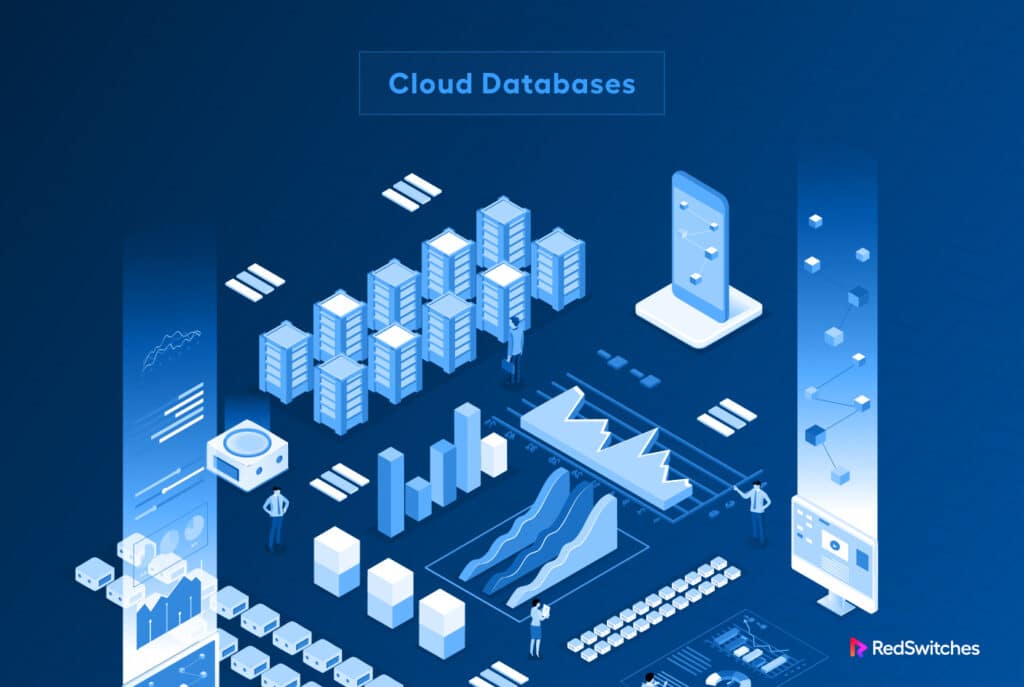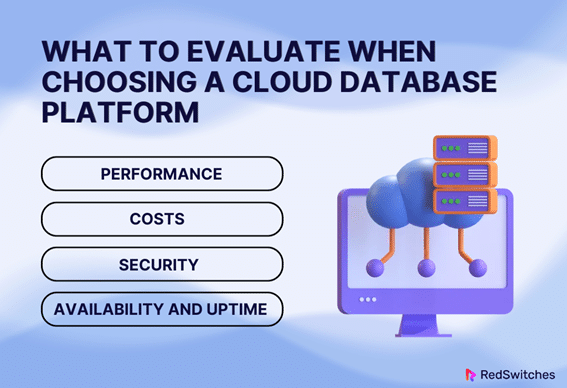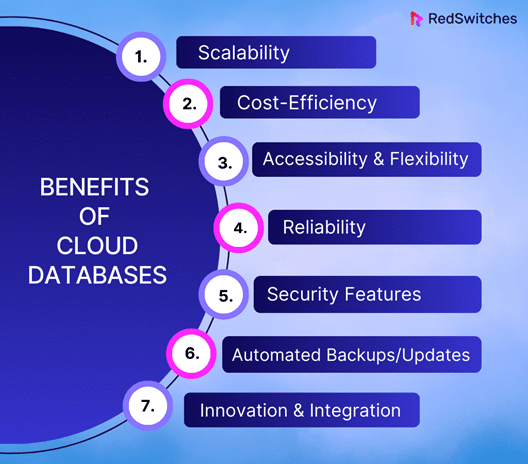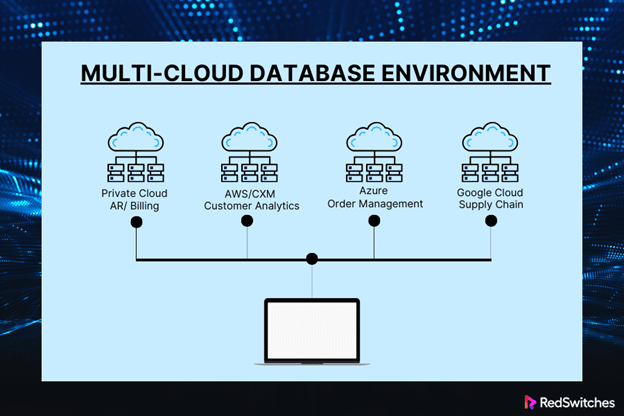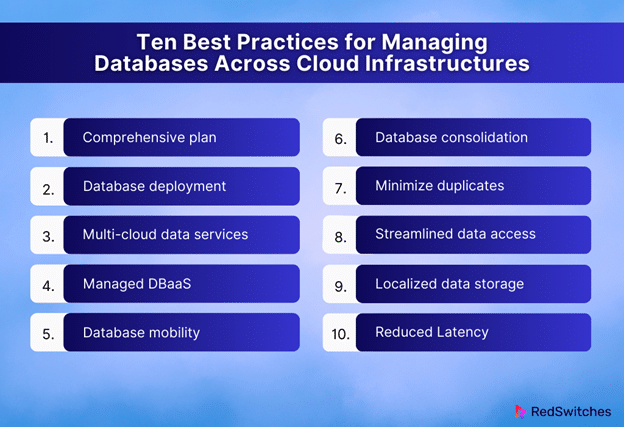Given the rise of cloud hosting as the primary mode of hosting enterprise and SMB projects, cloud databases have emerged as an innovative data management and storage technology.
A cloud database is a service provided by a cloud computing platform that is hosted, run, and accessible online. Compared to conventional on-premise databases, they offer more flexibility, scalability, and reliability as data components of business applications.
This article will go into the details of cloud databases, their major types and benefits, and the related information about migrations and future trends in cloud databases.
Table Of Contents
- What are Cloud Databases
- The Key Cloud Database Management System Components
- Major Types of Cloud Databases
- Cloud Database Deployment Methods
- Crucial Factors to Consider When Choosing a Cloud Database Platform
- Benefits of Cloud Databases
- Leading Cloud Database Providers
- Migrating Databases to the Cloud
- Cloud Database Architecture Considerations
- Cloud Database Security
- Conclusion
- FAQ’s
What are Cloud Databases
Cloud databases are database services that run on a cloud computing platform. They offer functionalities similar to a traditional database with additional services and advantages like scalability, cost-saving, robust performance, and broader accessibility. These benefits stem from these databases operating in a cloud environment.
These databases let users create, save, manage, and access data on cloud platforms, eliminating the need for expensive infrastructure and local storage. Business applications can easily handle data operations, maintain high availability, and ensure data security with the help of services like Cloud SQL or Cloud Datastore. In addition, cloud data warehouse solutions support data management and analytics at scale, optimizing data operations on huge datasets.
The fact that cloud databases provide affordable, scalable, and effective data management solutions in today’s data-driven environment fundamentally impacts how businesses access, examine, and use data to make decisions and enhance their operations.
The Key Cloud Database Management System Components
Like traditional DBMS technology, cloud database platforms have several components that work together to process and manage data. The following list covers these essential components that come together and deliver data management capabilities.
- An Engine for managing data storage
- A Catalog of metadata with details on database objects
- A Database Access Language for data query and modification (SQL is the most common DAL)
- A query process and a query optimization manager
- A Lock Manager to control concurrent data access
- A Log Manager to record changes made to the data
- A set of database management utilities
Interestingly, this structure and component list closely mirrors the more extensive cloud computing architecture. Read more about the cloud architecture in our in-depth guide.
Major Types of Cloud Databases
Cloud databases can be broadly classified into Relational databases (Cloud SQL) and Non-Relational databases (Cloud Datastore).
Based on their structural differences, each type of cloud database meets a different set of project requirements.
Cloud SQL: The Relational Approach
The relational model is the traditional database management approach, where data is organized into tables and rows with defined relationships between data items. Cloud SQL is a cloud service built on this well-established model.
Cloud SQL is a completely managed service that uses SQL for simplified database management and relational database maintenance in the cloud. It supports popular database engines such as MySQL, PostgreSQL, and SQL Server.
The appeal of Cloud SQL lies in its convenience. It removes complexities from managing servers, taking backups, data replication, and optimizing performance. Businesses opt for databases such as Cloud SQL to stop worrying about their cloud database infrastructure.
Cloud Datastore: The NoSQL Pathway
The non-relational database, or NoSQL, is a flexible and scalable approach to data management.
This model doesn’t use the traditional table and row format. Instead, it stores data in multiple ways -documents, key-value pairs, graphs, or wide-column stores. Most NoSQL databases are schema-less, which means the database doesn’t need to know the structure of the data before storing it.
Cloud data storage is often a fully managed, schema-less, NoSQL document-type service tailored for storing and querying non-relational data. It automatically scales as data volume increases, allowing for seamless data management. This model also supports strong consistency, high availability, and global transactions.
How Cloud Databases Work
Business applications use databases to collect, organize, and provide data for operational and analytical purposes.
Traditionally, these applications used on-site databases for storing and retrieving data.
Cloud databases often provide data processing, management, and access features similar to these on-site databases. As a result, it is usually easy to migrate on-premises databases and support apps to the cloud with few issues.
Cloud Database Deployment Methods
Businesses can choose between the two popular deployment methods.
Self-managed Databases
In this Infrastructure as a Service (IaaS) setting, the database is hosted on a virtual machine running on a cloud provider’s infrastructure.
The service provider manages and supports servers, operating systems, and storage hardware. The user is in charge of the database’s deployment, management, and upkeep.
Managed Database Services
The Database as a Service (DBaaS) environments are managed by the cloud platform provider, the vendor, or another database vendor using the platform provider’s infrastructure to run their cloud DBMS.
The customer handles the system infrastructure and database platform from the DBaaS control panel. The DBA manages the database and collaborates with the DBaaS provider for administrative activities, while the vendor handles provisioning, backups, scaling, patching upgrades, and other basic database administration chores.
If you wish to set up a cloud-based data warehouse, you can find vendors offering Data Warehouse as a Service (DWaaS) options.
Additionally, several cloud service providers, like Oracle and Amazon Web Services (AWS), offer different iterations of their DBaaS technologies for installation in on-premises data centers as part of a private cloud or a hybrid cloud infrastructure.
The approach differs from the typical Database as a Service (DBaaS) setup. The database services are set up at the on-premises infrastructure, but the vendor retains remote control of the database. In this hybrid scenario, the provider retains control and management of the database while the physical infrastructure is hosted at the user’s data center.
Pricing is a critical business consideration, and cloud databases offer similar price advantages as on-premises databases. In most cases, cloud database vendors follow a pay-as-you-go model where users pay for resources consumed during processing workloads and ensuring data persistence.
Alternatively, users can book database instances in advance, often in year-long contracts, to receive special pricing on routine workloads with predictable capacity needs.
Crucial Factors to Consider When Choosing a Cloud Database Platform
When evaluating cloud databases for new and existing projects, businesses should consider the following significant factors and concerns:
Performance
This is probably the most critical factor, especially if the database serves high-performance, high-demand applications.
Scalability is another related crucial requirement ensuring the database continues functioning under increasing real-time data requests and processing load.
The platform should offer dedicated components for monitoring database performance.
Costs
Costs of using cloud databases are determined using several pricing models that are clearly explained in the pricing details. In addition, cloud providers offer free online cost calculators that businesses can use to estimate the costs of their current and future database capacity requirements. Note that several factors, such as service configurations and processing regions, affect the running costs of cloud databases.
Availability & Uptime
Availability and uptime in a cloud database environment refer to how reliably the service remains accessible. It’s about ensuring the database is consistently available without disruptions.
The SLA offered by the cloud database vendor should clearly define uptime, high availability, disaster recovery, and data backup and recovery capabilities.
Security
Security in a cloud database platform boils down to protecting your data from unauthorized access and breaches. To ensure this, cloud database vendors offer security features like encryption, access controls, and regular updates to keep data safe. You should check compliance with relevant security standards and regulations when selecting cloud database platforms.
Although the vendor is not completely responsible for securing a DBaaS environment, it is essential to understand the security capabilities and measures the vendor offers. This allows businesses to develop a coordinated security protocol that complements the vendor’s security features.
Benefits of Cloud Databases
Now that you know how cloud databases work and how businesses can opt to implement them for their operations, let’s discuss the benefits businesses get from using cloud databases over on-site databases:
Increased Scalability and Flexibility
Cloud database systems quickly scale when workloads expand by adding more processing and storage capacity. Some vendors offer auto-scaling capabilities that dynamically increase capacity and resources without requiring a customer request or manual intervention.
Similarly, the business can quickly launch new databases and deactivate (or delete) them when no longer needed. For businesses, this makes DBaaS an integral and cost-effective component of operational infrastructure.
Reduced On-premises Infrastructure Costs
The cloud provider handles the system infrastructure in a cloud database environment, especially when a business migrates its on-premises databases to the cloud. As a result, the spending on the on-premises infrastructure is greatly reduced as the database vendor takes on the responsibilities and costs of infrastructure maintenance.
Faster Access to New Features
In an on-premises environment, users must wait a significant time before using new and emerging database features. In most cases, ICT teams take their time to test new features to assess their impact on the existing infrastructure.
In contrast, DBaaS providers regularly upgrade their cloud databases, allowing businesses to benefit from new capabilities as soon as they become available to the users.
High Reliability and Guaranteed Uptime
Cloud vendors offer automatic backup, high availability, and disaster recovery features that are often more responsive and sophisticated than what a business can deploy at on-premises database infrastructure. DBaaS vendors also promise uptime guarantees for their services as part of their cloud service-level agreement (cloud SLA).
Cost Savings
When a business migrates to a cloud database, it sees a significant drop in database expenditures because of decreased capital expenses, data center running costs, and database infrastructure maintenance costs.
You should note that the pay-as-you-go billing model cloud database vendors use might not be a great fit for your requirements, especially when you overrun the database capacity budget. We highly recommend that businesses closely monitor database usage, especially read/write requests. This is crucial for optimizing the overall resource consumption and cloud database operational costs.
Leading Cloud Database Providers
Unsurprisingly, the top cloud platform providers AWS, Google Cloud, Microsoft, and Oracle are also the leading cloud database vendors. All three provide multiple cloud databases, including relational, NoSQL, and data warehouse. These vendors support IaaS and DBaaS modes on their platforms.
Other well-known cloud database providers include:
- IBM and SAP, two very popular ICT vendors, have moved away from on-premises databases and now provide a wide range of cloud DBaaS services.
- If you’re looking for NoSQL DBaaS options, we recommend Couchbase, DataStax, MongoDB, Neo4j, and Redis.
- Yellowbrick Data and Snowflake are two popular cloud data warehouse platforms.
- Exasol and Teradata are well-known providers of analytics databases.
- If you are in the open-source camp, consider EDB and MariaDB, two popular relational open-source databases.
- If you need multi-model databases for your projects, check out InterSystems and MarkLogic.
- Cockroach Labs and Yugabyte are vendors of distributed SQL databases.
Migrating Databases to the Cloud
At this point, we’ve discussed the capabilities and benefits of cloud databases. Now, let’s discuss the idea of migrating on-premises databases to the cloud.
This is a critical process because businesses expect significant savings and relief in operational resource consumption from this move. Moving a database to the cloud can be a useful strategy to improve process efficiency and overall application performance as part of more extensive cloud deployment.
However, moving a database can be a complex operation.
Before the move, the ICT teams must design a database migration plan covering all critical aspects. These aspects include deciding between a vendor-managed DBaaS environment or a self-managed IaaS environment and whether to switch to the current DBMS’s cloud version or different database technology.
The plan should also answer secondary questions, such as whether switching databases could be advantageous in terms of cost-savings or additional database functionality.
A crucial consideration in the migration process is that on-premises and cloud database solutions don’t completely overlap, especially in terms of features. For instance, while Microsoft’s SQL Server relational cloud service and its on-premises counterpart, SQL Server, share a common code base, some incompatibilities between the two products make it necessary to restructure SQL Server databases before moving them to Azure SQL Database.
Cloud Database Architecture Considerations
A single public cloud platform is the easiest method for implementing cloud databases. Even if different DBaaS providers are involved, this simple choice guarantees consistency in the underlying cloud architecture managed by a single cloud provider.
However, this simple configuration is not always practical or fulfills the business’s operational and ICT requirements. In such cases, vendors and the business ICT teams can configure databases in a hybrid, public, or on-premises private cloud.
10 Best Practices for Managing Databases Across Cloud Infrastructures
Here are the 10 best practices for managing databases across several clouds:
- Create a governance framework and a comprehensive management plan.
- Deploy/Provision the appropriate database in the appropriate cloud.
- Utilize data services that work across different cloud settings.
- Opt for Database as a Service (DBaaS) for efficient management.
- Think about database mobility between several clouds.
- Decrease the variety of databases.
- Minimize (or ideally eliminate) identical databases.
- Streamline how apps and users access data.
- When possible, keep data on a single cloud platform to reduce complexity.
- Connect to cloud networks to reduce delays in data access.
Cloud Database Security
As mentioned earlier, the DBaaS provider is not solely responsible for cloud database security.
The provider can handle a variety of security tasks on managed DBaaS platforms. DBaaS vendors take on additional responsibility for safeguarding the database platform.
However, users are responsible for handling database security in IaaS environments because they deploy and manage the database and environment.
Conclusion
Cloud databases have transformed the management and storage of data. They provide unmatched scalability, accessibility, and cost-effectiveness. This enables businesses to easily manage, store, and analyze massive amounts of data without requiring a robust on-premises infrastructure.
Cloud databases are the driving force behind future technologies like blockchain, serverless computing, edge computing, AI analytics, and multi-cloud strategies. Thanks to the capabilities and functionality of cloud databases, these products and services enable businesses to make data-driven decisions and gain competitive advantages.
For many businesses, cloud databases are crucial for remaining flexible and quickly adapting to changing market conditions.
Are you looking for reliable and scalable database hosting solutions?
If you’re looking for a robust server for your projects, RedSwitches offers the best dedicated server pricing and delivers instant dedicated servers, usually on the same day the order gets approved. Whether you need a dedicated servers, a traffic-friendly 10Gbps dedicated server, or a powerful bare metal server, we are your trusted hosting partner.
FAQs
Q. What is a cloud database?
A cloud database, hosted and managed by a cloud service provider on remote servers, enables users to store, manage, and access data via the Internet, providing scalability and cost-effectiveness.
Q. How does a cloud database work?
Cloud databases use multiple servers in different locations to store data. Users access data through the Internet while the provider manages storage, replication, and backups.
Q. What are the advantages of using a cloud database?
The benefits of cloud databases include cost-effectiveness due to pay-per-use pricing, data redundancy for more excellent reliability, scalability to handle varied workloads, and access from any location with an internet connection.
Q. Is data stored in a cloud database secure?
Cloud database providers prioritize security, including encryption, access controls, and compliance certifications, to protect data and ensure privacy.
Q. How can I migrate my existing database to a cloud database?
Migrating to a cloud database involves planning, data preparation, and testing. Most cloud providers offer migration tools and services to ease the process and ensure a smooth transition.
Q. Can I use a cloud database for real-time analytics?
Cloud databases support real-time analytics by utilizing advanced analytical tools and integrating with other cloud services like data warehousing and big data solutions.
Q. What happens if there is a data breach in a cloud database?
If there’s a data breach, cloud providers have robust security plans to minimize damage and protect sensitive data.
Q. Can I integrate my cloud database with other cloud services?
Cloud databases easily connect with AI, machine learning, IoT, and other services to enhance data analysis and decision-making.
Q. Are there different types of cloud databases?
Yes, cloud databases come in different types, including relational databases, NoSQL databases, graph databases, and time-series databases, each tailored to specific data storage and processing needs.
Q. How do I choose the suitable cloud database for my business?
Choosing the right cloud database involves considering scalability requirements, budget, and integration needs. Evaluating different providers and their offerings will help you make an informed decision.
